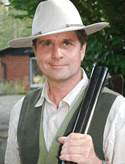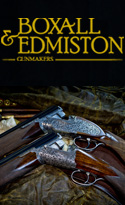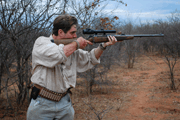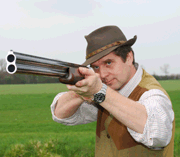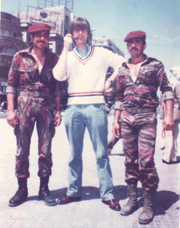Different Shooting Techniques and Forward Allowance
Forward allowance is a subject guaranteed to get any group of shooters talking. Some swear that they do not see a gap when they shoot the birds, most of us do though, whether we apply lead consciously or unconsciously. There are all sorts of system for applying forward allowance. One may ‘Swing-Through’ from behind, one can touch the bird and ‘Pull-Away,’ or you can ‘Maintain a Lead.’ Some spot shoot their birds – bring the gun straight up to a point in front of the target without much if any swing. It can all get pretty confusing, so the purpose of this article is to explain some of these different systems to you in a little more depth, and to get you experiment.
Swing Through
Let’s start with the traditional way of shooting – Swing Through, a.k.a ‘the smoke-trail-method’. The idea, of course, is that you start from behind the target (you don’t have to be miles behind) and then move smoothly through it, firing instinctively as you come in front. The idea is to brush the birds out of the sky. The method works very well. It encourages good gun, flowing, gun movement and it is, in my opinion, one of the best ways to shoot game consistently. Swing through is especially good for establishing line, and it usually ensures that you shoot with a moving gun too – critical in the field when birds are moving fast.
The method is graceful, but it requires that you develop your basic mount and swing to perfection. The power for the swing, remember, should always come from body rotation (or, in the case of overhead birds, body bending), the fine control comes from the hands. Every clay and game shot should learn the Swing Through technique. It is aided by a well-balanced gun and good stock fit. It can come into its own on longer birds where there is a tendency to give them insufficient lead or to stop.
Pull Away
Pull-Away is also a very useful technique. In the best known form – as taught by the CPSA for clays – one mounts on to the moving bird, tracks it, and then pulls in front (again firing instinctively). I have found this an excellent method for teaching beginners, it also has other uses. I call Pull Away the ‘get-you-out-of-trouble’ method. When everything is going wrong on clay layout, or when you note a lot of peole having trouble on a particular stand, I often suggest to my students that they default to Pull Away. You know that you are starting on the bird – you’re ensuring that you are in the same ball park – and the method can work very well with deceptive angles birds or targets which are slow. It is not a good game shooting method, nor is it the method of choice for very fast birds (where there is no opportunity to track).
Touch and Push
‘Touch and Push’, as I have now named it, is a related technique. I have developed it for both game and clay shooting (though people have probably been doing something very similar for years). It’s very simple. With Touch and Push bring the tip of the un-mounted gun to the bird and push ahead. There is no intermediate tracking stage and the gun is not in the shoulder as it first comes to the bird. Its advantage is that it makes you establish a relationship with the target immediately. Some people are very inconsistent in this respect, so doing it consciously can be a big help in improving their performance. The technique is based on natural pointing ability. Proper use of the body and front hand are still important.
Maintained Lead
Maintained Lead is well known to many shooters. It takes two distinct forms though. American skeet and wildfowl shooters employ a version where the gun is kept forward of the bird all the time – the basic idea of maintained lead shooting – but they apply a measured forward allowance. If we were on a skeet field, it might be 18” for the low bird on Station 2 (you have to find out what works for you), in the field you might be in a duck hide see a familiar presentation and say to yourself “now, I need to be 10 feet in front of that bird.”
The other form of maintained lead has been developed by John Bidwell with his MOVE:MOUNT:SHOOT technique. This is a maintained lead technique too – the bird never catches up with gun – but the lead is applied instinctively (if you are clay shooting stand towards the sweet spot, take the gun half way back and bring the muzzles about half-way down from the anticipated flight line – call for the bird, keep your eyes glued to it and let the rest happen naturally). It’s an excellent system for shooting clays, and John, of course, is its greatest exponent have won umpteen championships with this clever but simple method.
Spot Shooting
Finally, I mentioned spot shooting. This is usually an instinctive technique employed by those who have never had formal instruction, but it can work very well. You see the bird, you note (probably unconsciously) where it is going and you bring the gun up and fire at a spot in front of your target. Conscious ambushing can sometimes be required on a clayshoot. For example, where you are require to shoot a bird abnormally fast, or when you have a rabbit that must be shot in a narrow window. It is a difficult technique to master and worth a little practice.
Positive Shooting
My own POSITIVE SHOOTING SYSTEM is design for clay shooting only and is, in essence, the unconscious version of Touch and Push. With POSITIVE SHOOTING align your body to the killing point, bring the gun back to the spot where you first see the bird in focus – where you first see it as a solid object – and take your eyes back to the zone where you first see the target as a blur or streak. You will find if you do this that the muzzles come up to the bird naturally – neither swinging through from behind or maintaining a lead in front – and move smoothly through. Keep you eyes on the bird and nothing but the bird and fire without hesitation. The technique works well. It depends on good preparation and notes the three ‘Universals’ for the perfect shot are Visual Contact, Balance and Rhythm.
Get More Info and Videos on POSITIVE SHOOTING here.
Measuring
I am not one of those instructors who suggest one way is best. I get my students to try several techniques and see which suit them. Some people, moreover, can get on by applying lead more instinctively (as suggested by Robert Churchill and Major Ruffer) others need a more deliberate approach. I think that it is useful to know – even as someone who does most of their shooting instinctively – that required lead on a bird at 40 yards is going to be something in the region of 6-8 feet (more if the target is fast). To those that say “One man’s inch is another man’s yard” I would reply “not if he is looking at the bird.” Every target has what might be described as a ballistic lead – an actual distance that one must be ahead of it to allow for the velocity of shot and the speed of the bird itself. Cartridge velocity by the way makes a very tiny difference to forward allowance (it is only a significant issue when using very slow cartridges), but the speed and type of target does. As far as clays are concerned, midis and battues often need far more lead. Minis on the other hand move at about the same speed as a conventional target and are often missed in front. Any other issues yes. The speed of your swing (and consequently the acceleration of the gun) may effect your perception of lead. I also find that short barrelled guns and light guns seem to need more lead.


